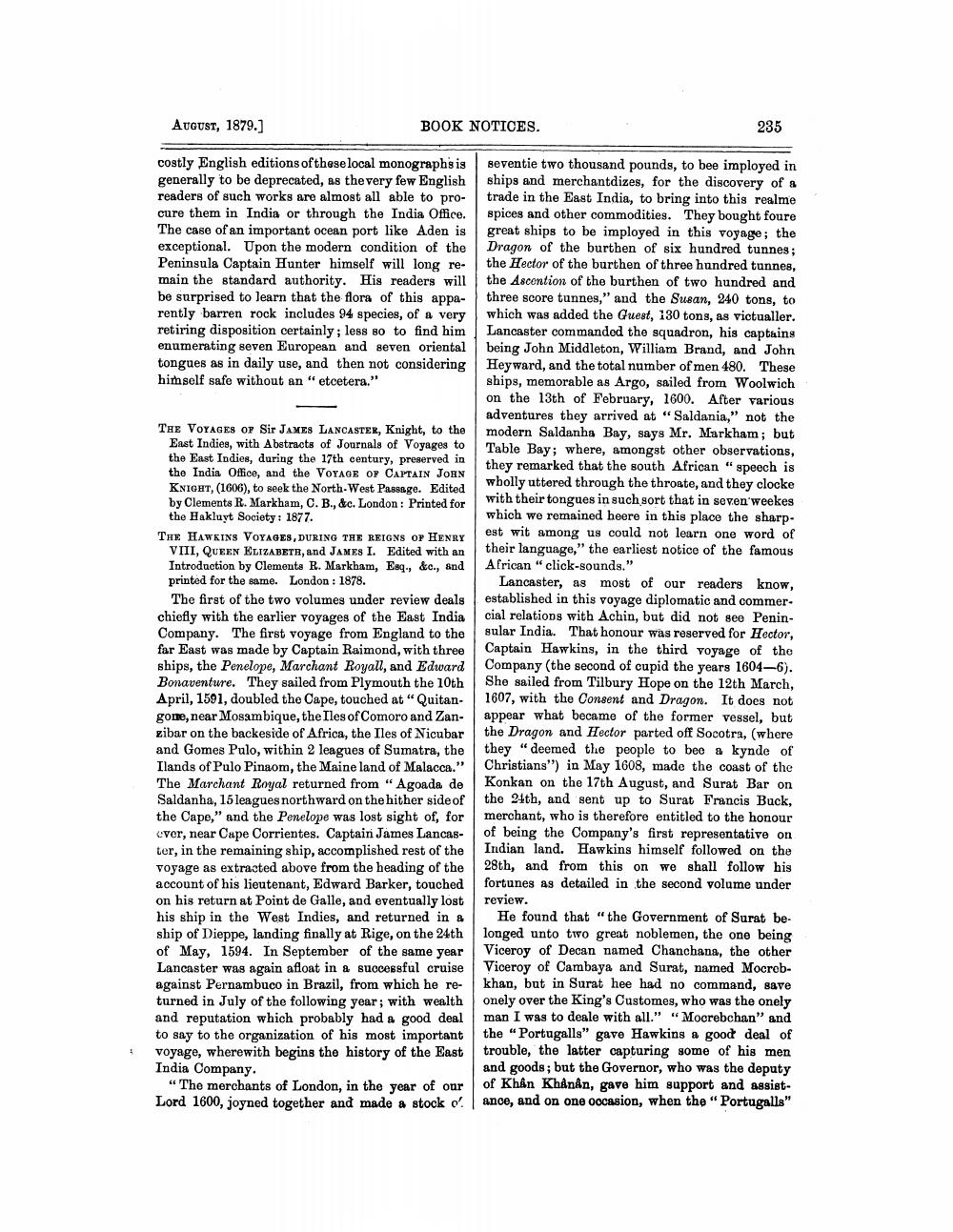________________
AUGUST, 1879.)
BOOK NOTICES.
235
costly English editions of these local monographs is generally to be deprecated, as the very few English readers of such works are almost all able to procure them in India or through the India Office. The case of an important ocean port like Aden is exceptional. Upon the modern condition of the Peninsula Captain Hunter himself will long remain the standard authority. His readers will be surprised to learn that the flora of this apparently barren rock includes 94 species, of a very retiring disposition certainly; less 80 to find him enumerating seven European and seven oriental tongues as in daily use, and then not considering himself safe without an "etcetera."
THE VOYAGES OF Sir JAMES LANCASTER, Knight, to the
East Indies, with Abstracts of Journals of Voyages to the East Indies, during the 17th century, preserved in the India Office, and the VOYAGE OF CAPTAIN JOHN KNIGHT, (1606), to seek the North-West Passage. Edited by Clements R. Markham, C. B., &c. London: Printed for the Hakluyt Society: 1877. THE HAWKINS VOYAGES, DURING THE REIGNS OP HENRY VIII, QUEEN ELIZABETA, and JAMES I. Edited with an Introduction by Clements R. Markham, Esq., &c., and printed for the same. London: 1878.
The first of the two volumes under review deals chiefly with the earlier voyages of the East India Company. The first voyage from England to the far East was made by Captain Raimond, with three ships, the Penelope, Marchant Royall, and Edward Bonaventure. They sailed from Plymouth the 10th April, 1591, doubled the Cape, touched at "Quitangore, near Mosambique, the Iles of Comoro and Zanzibar on the backeside of Africa, the Iles of Nicubar and Gomes Pulo, within 2 leagues of Sumatra, the Ilands of Pulo Pinaom, the Maine land of Malacca." The Marchant Royal returned from " Agoada de Saldanha, 15 leagues northward on the hither side of the Cape," and the Penelope was lost sight of, for
ver, near Cape Corrientes. Captain James Lancaster, in the remaining ship, accomplished rest of the voyage as extracted above from the heading of the account of his lieutenant, Edward Barker, touched on his return at Point de Galle, and eventually lost his ship in the West Indies, and returned in & ship of Dieppe, landing finally at Rige, on the 24th of May, 1594. In September of the same year Lancaster was again afloat in a successful cruise
ainet. Pernamhnen in Brazil. from which he re- turned in July of the following year; with wealth and reputation which probably had a good deal to say to the organization of his most important voyage, wherewith begins the history of the East India Company.
"The merchants of London, in the year of our Lord 1600, joyned together and made a stock o'
seventie two thousand pounds, to bee imployed in ships and merchantdizes, for the discovery of a trade in the East India, to bring into this realme spices and other commodities. They bought foure great ships to be imployed in this voyage; the Dragon of the burthen of six hundred tunnes; the Hector of the burthen of three hundred tunnes, the Ascontion of the burthen of two hundred and three score tunnes," and the Susan, 240 tons, to which was added the Guest, 130 tons, as victualler. Lancaster commanded the squadron, his captains being John Middleton, William Brand, and John Heyward, and the total number of men 480. These ships, memorable as Argo, sailed from Woolwich on the 13th of February, 1600. After various adventures they arrived at "Saldania," not the modern Saldanha Bay, says Mr. Markham; but Table Bay; where, amongst other observations, they remarked that the south African "speech is wholly uttered through the throate, and they clocke with their tongues in such gort that in seven weekes which we remained heere in this place the sharpest wit among us could not learn one word of their language," the earliest notice of the famous African "click-sounds."
Lancaster, as most of our readers know, established in this voyage diplomatic and commer. cial relations with Achin, but did not see Peninsular India. That honour was reserved for Hector, Captain Hawkins, in the third voyage of the Company (the second of cupid the years 1604-6). She sailed from Tilbury Hope on the 12th March, 1607, with the Consent and Dragon. It does not appear what became of the former vessel, but the Dragon and Hector parted off Socotra, (where they "deemed the people to bee a kynde of Christians') in May 1608, made the coast of the Konkan on the 17th August, and Surat Bar on the 24th, and sent up to Surat Francis Buck, merchant, who is therefore entitled to the honour of being the Company's first representative on Indian land. Hawkins himself followed on the 28th, and from this on we shall follow his fortunes as detailed in the second volume under review.
He found that "the Government of Surat belonged unto two great noblemen, the one being Viceroy of Decan named Chanchana, the other Viceroy of Cambaya and Surat, named Mocrobkhan, but in Surat hee had no command, gave onely over the King's Customes, who was the onely man I was to deale with all." "Mocrebchan" and the "Portugalls" gave Hawkins a good deal of trouble, the latter capturing some of his men and goods; but the Governor, who was the deputy of Khan Khånån, gave him support and assistance, and on one occasion, when the "Portugalls"




